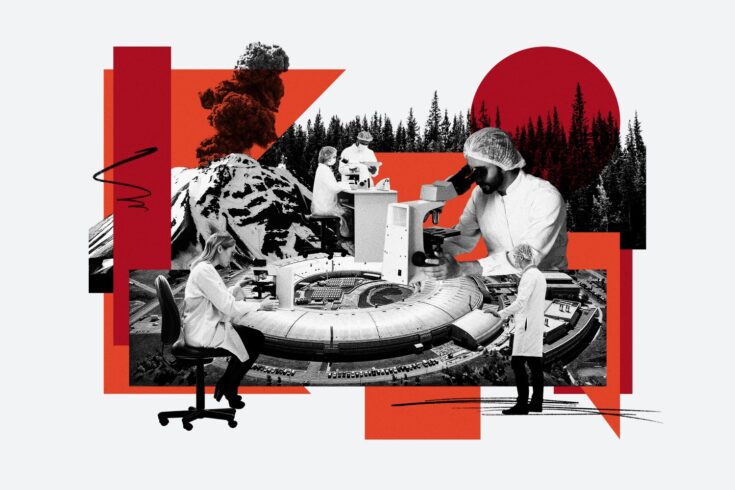I remember as a child accompanying my father in the Natural Environment Research Council (NERC) Land Rover for some deer tracking. He was a researcher at a NERC institute at the time and later went on to be the director.
It was an early lesson for me that not every piece of infrastructure is a shiny glossy building or an expensive piece of equipment. That Land Rover (with built in radio tracking antenna) was needed for ecological research on the Scottish red deer population, which was not well known for frequenting easy-to-reach habitats.
I was also recently reminded that Richard Henderson’s Nobel Prize was facilitated by years of work at the Medical Research Council (MRC) Laboratory of Molecular Biology, using their freezers, centrifuges, incubators and many more key pieces of equipment.
When you think about it, these small pieces of quite ordinary equipment and national facilities have supported the training of so many PhDs and technical staff and enabled so much ground-breaking research.
When I talk about research and innovation infrastructure, I mean things that cost more than £10,000, what you might describe as capital investment. A colleague once said that UKRI is essentially about people, ideas and stuff. The many of us who work across UKRI on infrastructure help support “the stuff”.
I’m convinced “this stuff” is essential whether it is big and shiny like the Large Hadron Collider or a small bit of essential lab equipment used for many people, whether it is a building or a computer, whether it is a cell microscope or a humanities historic archive.
We are making a difference in thousands of labs
We are funding “the stuff” because it is essential to maintaining the UK as a centre for world-class research. There are hundreds of thousands of pieces of laboratory equipment supported by our World Class Labs funding.
It makes an enormous difference at the level of each and every one of those laboratories. We often get letters back saying what a difference it makes.
We are also doing it because we need to be ready. Sometimes, you don’t know that a piece of infrastructure you have funded is going to be vital at a time of national emergency.
I remember the Eyjafjallajökull volcanic eruption in Iceland in 2010 when a huge cloud of volcanic ash disrupted air travel.
NERC was able to send up its plane (The FAAM Airborne Laboratory) to take measurements and find out what was going on. We couldn’t have responded so quickly without our previous infrastructure investment. This and many other investments are part of UKRI infrastructure.
I would also be remiss if I did not mention the varied data these equipment and facilities generate and how that data requires infrastructure investments in itself to store, analyse, model, and predict, managed through the UKRI digital infrastructure programme.
Infrastructure came into its own during COVID-19
The COVID-19 pandemic is another example. The Diamond Light Source was used to understand the structure of the spike protein. That’s a past investment of many hundreds of millions.
Investments in the UK Biobank gave us access to a huge amount of health data so we could, for example, understand how antibodies persist post infection.
Similarly past investments in high containment labs such as Pirbright meant we had facilities to examine the virus and support vaccine development.
The ongoing digitisation of historic and contemporary social records also gave us unprecedented understanding into the socioeconomic consequences of the pandemic.
Funding is tight so we need to share resources
We know that public funding is tight, so we have to make the infrastructure funding stretch to help as many communities as we can.
This brings me to something I’m passionate about, the sharing of resources.
Our country can only have one synchrotron, which everyone shares, but sharing should also be the case for most of our laboratory facilities and equipment.
I’ve worked at various councils on funding of capital equipment, and I’ve always encouraged sharing of that equipment with those in the next-door laboratory, on the next floor or in a different institution.
When I worked as a researcher I experienced it myself. You couldn’t use the equipment in the lab next door because it “belonged to them”. The sector has significantly improved its equipment sharing since my days in the lab, but we still have pockets of suboptimal behaviours.
You solve things by sharing and working together
There is a strong focus across UKRI now on how we can get better value for money by encouraging the sharing of resources. This in turn fosters collaboration and transdisciplinary research.
Net zero is also driving a greater need for pooling and sharing, whether within institutions or as national infrastructures. We don’t want lots of equipment sitting around with embedded carbon and not being used, and the pooling of equipment has energy benefits such as shared (more efficient) cooling.
Support for technical skills is also extremely important. A lot of the equipment we fund is increasingly complex and it is better to have it in a suite of shared facilities where you have technical experts to run it and maintain it. You can also then properly train the users and next generation of research technicians.
I see this sharing of facilities now happening naturally. The COVID-19 pandemic made us realise that we solve things through lots of disciplines working together and sharing knowledge and facilities.
Technologies no longer belong to just one community. Take the mass spectrometer. It essentially measures molecules. Biologists use it for examining biological activity, and the environmental community uses it for monitoring pollution in rivers. Physicists use it for understanding the properties of new materials, and the arts and humanities community uses it for understanding paintings or archaeological samples.
We need to look to the future
Our roadmap for infrastructure is almost five years old now.
Much of it is still pertinent, so we won’t be rewriting it. However we’ll be looking to refresh it and celebrate what we have done over the last five years to support research infrastructures and their importance for growth, jobs, training and making the UK a place people want to invest in.
We must also keep the UK research base at the forefront of international research and innovation with the latest cutting-edge equipment and data resources. These not only enable research but also support innovation and growth of our economic base.
I’d say it’s also important for us to look at what we need to do to maintain future financial sustainability. We have big historic challenges across ageing university and research-council estates. A lot of buildings are old, poorly designed for 21st-century research, and very energy inefficient.
Feeling the passion of our research community
I’m responsible for “the stuff” but I’ll always champion people who manage it. “The stuff” comprises clever design of concrete, electrical components and data. It’s nothing without the people. Often, these are technically skilled people who have been undervalued for too many years.
We often champion the ideas but a lot of the things in your everyday life, your smartphone or the medicine you take, come out of research and development that was done using infrastructure investments supported with an unsung ensemble of technical support staff, estates professionals and the other backroom staff who run facilities.
Last thoughts
I’m a second-generation scientist but too much of a polymath to be an academic. Someone like Leonardo Da Vinci inspires me. One day he is working on his art, the next day he is thinking about science and flying machines.
What I love about this job is I get to see so many exciting ideas in so many different areas. My team and the wider infrastructure teams across UKRI often share that passion. There’s something great about looking across our whole portfolio and the different lives it impacts.
We love the excitement and passion of the people who run all these facilities we support. We feel it every time we visit them. I had the pleasure of being at the Daresbury Laboratory recently, and the passion and dedication of the staff there gives me the energy to do my best in supporting them.




